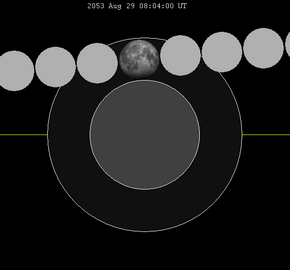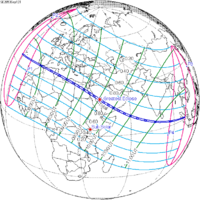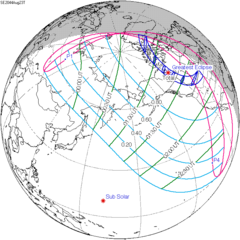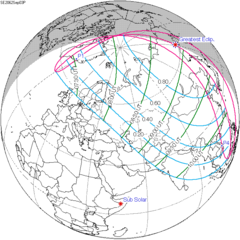|
August 2053 lunar eclipse
A penumbral lunar eclipse will occur at the Moon’s descending node of orbit on Friday, August 29, 2053,[1] with an umbral magnitude of −0.0319. It will be a relatively rare total penumbral lunar eclipse, with the Moon passing entirely within the penumbral shadow without entering the darker umbral shadow.[2] A lunar eclipse occurs when the Moon moves into the Earth's shadow, causing the Moon to be darkened. A penumbral lunar eclipse occurs when part or all of the Moon's near side passes into the Earth's penumbra. Unlike a solar eclipse, which can only be viewed from a relatively small area of the world, a lunar eclipse may be viewed from anywhere on the night side of Earth. Occurring about 4.7 days after apogee (on August 24, 2053, at 14:30 UTC), the Moon's apparent diameter will be smaller.[3] VisibilityThe eclipse will be completely visible over much of North America and western South America, seen rising over northeast Asia and Australia and setting over eastern South America and west Africa.[4] Eclipse detailsShown below is a table displaying details about this particular solar eclipse. It describes various parameters pertaining to this eclipse.[5]
Eclipse seasonThis eclipse is part of an eclipse season, a period, roughly every six months, when eclipses occur. Only two (or occasionally three) eclipse seasons occur each year, and each season lasts about 35 days and repeats just short of six months (173 days) later; thus two full eclipse seasons always occur each year. Either two or three eclipses happen each eclipse season. In the sequence below, each eclipse is separated by a fortnight.
Related eclipsesEclipses in 2053
Metonic
Tzolkinex
Half-Saros
Tritos
Lunar Saros 119
Inex
Triad
Lunar eclipses of 2053–2056This eclipse is a member of a semester series. An eclipse in a semester series of lunar eclipses repeats approximately every 177 days and 4 hours (a semester) at alternating nodes of the Moon's orbit.[6] The penumbral lunar eclipses on June 27, 2056 and December 22, 2056 occur in the next lunar year eclipse set.
Saros 119This eclipse is a part of Saros series 119, repeating every 18 years, 11 days, and containing 82 events. The series started with a penumbral lunar eclipse on October 14, 935 AD. It contains partial eclipses from May 18, 1296 through August 2, 1422; total eclipses from August 13, 1440 through June 15, 1927; and a second set of partial eclipses from June 25, 1945 through August 19, 2035. The series ends at member 82 as a penumbral eclipse on March 25, 2396. The longest duration of totality was produced by member 49 at 102 minutes, 6 seconds on March 30, 1801. All eclipses in this series occur at the Moon’s descending node of orbit.[7]
Eclipses are tabulated in three columns; every third eclipse in the same column is one exeligmos apart, so they all cast shadows over approximately the same parts of the Earth.
Half-Saros cycleA lunar eclipse will be preceded and followed by solar eclipses by 9 years and 5.5 days (a half saros).[9] This lunar eclipse is related to two solar eclipses of Solar Saros 126.
See alsoReferences
External links
|
||||||||||||||||||||||||||||||||||||||||||||||||||||||||||||||||||||||||||||||||||||||||||||||||||||||||||||||||||||||||||||||||||||||||||||||||||||||||||||||||||||||||||||||||||||||||||||||||||||||||||||||||||||||||||||||||||||||||||||||||||||||||||||||||||||||||||||||||||||||||||||||||||
Portal di Ensiklopedia Dunia






































